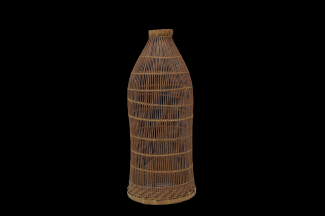Jakarta, circa 1986
The traditional fish trap, also known as a "bubu," is made from woven bamboo and comes in various shapes. It is commonly used in several regions of the Nusantara archipelago and Australia.
The bubu reflects local wisdom and traditional knowledge about fishing technology. It is used by placing the trap along the path where fish pass. The mouth of the bubu trap is wide at the outer edge and narrows towards the inside. This design prevents the fish from escaping once they are trapped. Bubu also represents as a cultural heritage and an identity for local communities. The crafting and use of bubu often involve skills and traditions passed down through generations.
To this day, bubu remains in use by fishermen in several regions of Indonesia, including Jakarta, for both saltwater and freshwater fishing. One community that still uses bubu as a fishing tool is the fishing community in the Cilincing area. According to their statements, bamboo traps are typically used for freshwater fishing. For saltwater fishing, however, fishermen use bubu made from iron or wire, shaped like a cube and sometimes collapsible. This difference arises because freshwater currents tend to be calmer than saltwater currents, while wire/iron bubu is sturdier against strong currents compared to bamboo bubu.
Inventory Number: MSJ/ETG/PRL/0195
Material: Bamboo
Dimensions: Height 70 cm, Diameter 23 cm
Salma Alfrida from Pamong Budaya Pelaksana, UP. Museum Kesejarahan Jakarta, shares the significance of the Bubu.
Curators
Intan Cahyanita | Museum of Fine Art and Ceramics
Dewie Novieana | Museum of Fine Art and Ceramics
Karima Marti Saraswati | Textile Museum Jakarta
Salma Afrida | Jakarta History Museum






